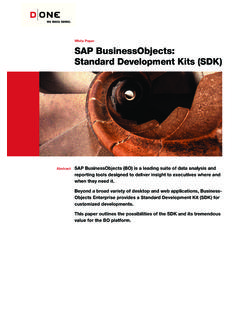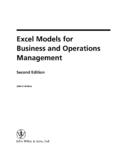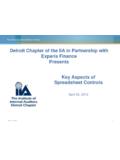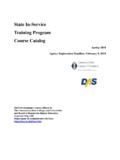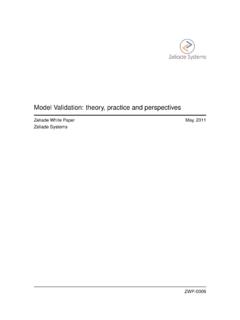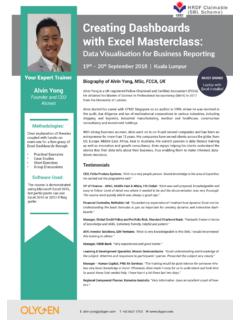Transcription of The FAST Standard
1 The fast . Standard Practical, structured design rules for financial modelling. Version/ fast Standard 02b June 2016. fast Standard 02b June 2016 / 1. i Contents Introduction/. Welcome to the fast Standard Introduction 3 Welcome to the fast Standard 5 The fast Philosophy 7 The fast Acronym 8 How Rules are Organised 9 A Living Document 10 Document Conventions 13 Workbook Design 15 General Workbook Design Principles 19 Sheet Organisation 20 Multiple Workbook Models 22 Worksheet Design 23 Universal Design Layout Principles 25 Calculation Blocks 27 Header Design 28 Input Sheets 29 Presentation Sheets 31 Control Sheets 32 The Line Item 33 Line Item Taxonomy 35 Formula Design Fundamentals 36 Formula Simplicity 40 Formula Clarity 42 fast Labelling Conventions 45 Links 46 Timing Flags and PPFs 48 Excel Features Used in Modelling 49 Excel Functions 51 Formatting Features 52 Excel Names 53 Data Validation 53 Group Outline 53 Macros / VBA
2 Considerations 54 Appendix A: fast Formatting 56 Appendix B: fast Terminology 62 Appendix C: Rules in Short 2 / fast Standard 02b June 2016 fast Standard 02b June 2016 / 3. Welcome to The fast . the fast Philosophy Standard The fast Standard is published openly and regularly revised by the fast Standard Organisation. The Signatories to the fast Standard believe financial models must be as simple as possible, but no simpler. Any model that is unnecessarily Welcome to the fast Standard , a set of rules on complicated is not good. Without simplicity the structure and detailed design of spreadsheet- supported by rigorous structure a financial based models. model will be poorly suited to its sole purpose . supporting informed business decisions. This Standard set of rules provides both a clear route to good model design for the individual modeller, and a common style platform on The Standard advocates a philosophy of good financial model design which modellers and reviewers can rely when rules founded on the acronym fast : flexible, appropriate, structured, and transparent.
3 It advocates transparent model structure and clear, crisp passing models amongst themselves. modelling style. See section The fast Acronym on page 7, for details on each of these fundamental design priorities. See How Rules are Organised, page 7, for a discussion on how these rules are organised and numbered. The fast Standard is primarily concerned with good spreadsheet design. While its remit does not extend to the management and control environment in which spreadsheets are used (such as back-up, version control and testing), modellers using the Standard are encouraged to consider these important aspects of the business environment when building and deploying their models. The Standard has been developed from the experience of industry practitioners who have learned simple techniques to replace overly-clever good ideas' that proved bad in practice over time.
4 It documents a skilled craft that is functional within the realities of the business environment. As a minimum objective, models must be free of fundamental omissions and logical errors, and this outcome must be achieved under short lead times. However, a good model must achieve more than this minimum Standard . It must be easily used and reviewed by others and readily adaptable as circumstances change. The fast Standard speaks predominantly about outcomes, what the final model should look like. It dwells little on the trade-craft of executing spreadsheet models, with specifics related to Microsoft Excel-based execution. For instance, it does not detail the use of recommended Excel keystrokes or so-called shortcut keys vastly superior to using a mouse in almost all circumstances on which the fast Standard relies.
5 4 / fast Standard 02b June 2016 fast Standard 02b June 2016 / 5. The fast . The fast . However, no set of design rules can be entirely divorced from the manufacturing environment in which the product must be built. Many of Philosophy the design rules are expressly recommended because of the strengths Acronym and weaknesses of the Microsoft Excel modelling environment, providing designs that take advantage of the environment's strengths and mitigating its weaknesses. Recommending design that takes advantage of efficient and error-reducing construction techniques is one of the prime objectives of the fast Standard . Finally, the fast Standard presumes the reader has a good understanding of Excel; this is not a how to' document, but a professional Standard supported by expert modellers.
6 Flexible Model design and modelling techniques must allow models to be both flexible in the immediate term and adaptable in the longer term. Models must allow users to run scenarios and sensitivities and make modifications over an extended period as new information becomes available -- even by different modellers. A. flexible model is not an all-singing, all-dancing template model with an option switch for every eventuality. Flexibility is born of simplicity. Appropriate Models must reflect key business assumptions directly and faithfully without being over-built or cluttered with unnecessary detail. The modeller must not lose sight of what a model is: a good representation of reality, not reality itself. Spurious precision is distracting, verging on dangerous, particularly when it is unbalanced.
7 For example, over-specifying tax assumptions may lead to an expectation that all elements of the model are equally certain and, for example, lead to a false impression, if the revenue forecast is essentially guesswork. An overly precise base case only serves to drown analytically more important scenario-based risk analysis and likely ensures the model is incapable of con- ducting Monte Carlo analyses practically. Structured Rigorous consistency in model layout and organisation is essential to retain a model's logical integrity over time, particularly as a model's author may change. A consistent approach to structuring workbooks, worksheets and formulas saves time when building, learning, or maintaining the model. Transparent Models must rely on simple, clear formulas that can be understood by other modellers and non-modellers alike.
8 Confidence in a financial model's integrity can only be assured with clarity of logic structure and layout. Many recommen- dations that enhance transparency also increase the flexibility of the model to be adapted over time and make it more easily reviewed. Fundamental to supporting each of these aims is the root definition of the term analysis the concept of breaking things up'. This theme must be applied at different levels of model design: tactically in forming short, simple formulas;. functionally to separate timing, escalation, and monetary calculations; and struc- turally at the level of worksheet purpose. 6 / fast Standard 02b June 2016 fast Standard 02b June 2016 / 7. How A Living Rules are Document Organised The Standard is an evolving document and discussion on points of the Stand- ard are ongoing.
9 You can join in the discussion on the fast Standard Organisation website: The fast website is being updated to accompany the new published Standard . Nearly all modelling design decisions are objectively good or bad; a minority You can sign up at to be informed when the new site is of modelling alternatives are simply one modeller's preferred approach over available and the revised fast Standard has been published. another. Hence the fast Standard is fundamentally organised around a set of rules dos and don'ts Following the recommendations of the fast Standard moderators, this document Rules are meant to be broken. However, such pragmatic behaviour does not is saved to a new version every time a major update is performed. The first version of render the rule book useless.
10 Breaking rules must be a conscious decision made the document is FAST01a, incrementing from a to z before reaching 02. with justification. Inexperienced modellers will know they are on thin ice' when breaking rules and will learn from experience when they have regretted rule- When a discussion has come to a conclusion, or a temporary agreement, the breaking in the past. conclusions are added to the Standard document as rules and exceptions. A new version of the document is issued every three months, or when there are several The Standard lists exceptions where breaking rules may be advisable. new rules to add to it, or significant changes to make to the existing Standard . Analogies between good modelling and good writing standards are legion, and this extends to the means of organising this specification: what works for the budding author works for the financial modeller.
